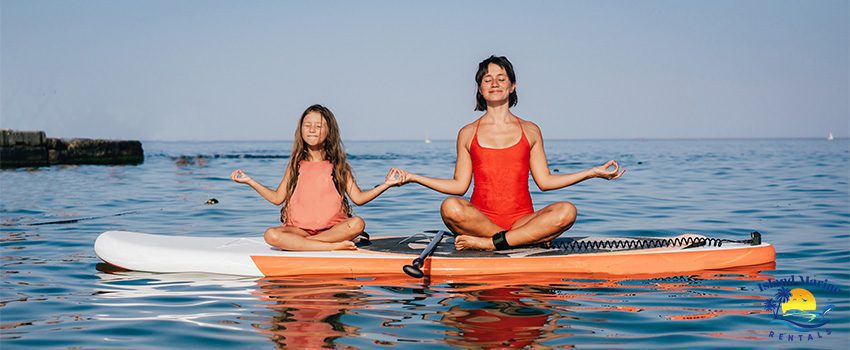While out on open water, cruising on a paddle board is already a fun activity, but you can make it even more worthwhile and add a therapeutic touch with stand up paddle board yoga.
What Is SUP Yoga?
Stand up paddle board yoga, or simply SUP yoga, involves practicing regular yoga poses on beautiful, calm bodies of water like bays, lakes, and harbors.
In recent years, paddle board yoga has become a popular water sport for yogis and those who love paddle boarding. With the challenge of performing poses on an unstable surface, many yogis dramatically improve their skills and gain a new perspective on many classic yoga poses.
While it may look intimidating, you’ll eventually find how easy and relaxing SUP yoga is once you give it a try and practice.
Benefits of SUP Yoga
SUP yoga is a great way to invigorate your yoga skills while taking in a breath of nature. It helps you build your core strength, focus, full-body awareness, and balance as you reconnect with your body and soul.
As a full-body workout, stand up paddle boarding yoga offers tons of health benefits, including:
- offering a new twist to your usual yoga routine;
- helping you become more mindful;
- improving mood and relieving stress;
- improving cognition;
- significantly improving balance;
- training your muscles — especially your core — in a new way;
- improving your strength and flexibility;
- helping you appreciate the outdoors; and
- renewing your passion for yoga.
Stand Up Paddle Board Yoga Essentials
Here are some reminders on what to bring and wear when attempting paddle board yoga:
- Stretchable, Water-Resistant Outfit
- Durable Paddle
- Anchor
- Personal Flotation Device (PDF)
- Leash
- Emergency Whistle
- Dry Bag
- Stand Up Paddle Board
Best SUP Yoga Paddle Boards
Since you’ll be practicing yoga poses on an unstable surface, the paddle boards for SUP yoga are designed differently. Compared to usual paddle boards, SUP yoga paddle boards possess more volume and have an extended deck pad.
In general, inflatable paddle boards are more stable and comfortable than epoxy paddle boards, usually floating higher on the water, making them great for practicing different yoga poses.
Here are some tips on how to choose the best paddle boards for yoga:
- Choose a board with a broad, stable deck to give you plenty of room to stretch.
- Pick a SUP that is at least 6-inches thick. A thinner board won’t support your weight and yoga poses.
- Steer clear of paddle boards less than 32 inches thick.
- Go for a long, comfortable traction pad to give you enough grip and space to switch poses.
- Look for a board with a capacity higher than your weight.
- Go for a board with permanent fins for shallow waters. Otherwise, choose one with detachable fins.
- Make sure your board has paddle holders or bungees.
- Choose a SUP yoga paddle board with a wide tip.
Beginner Tips for SUP Yoga
SUP yoga takes your usual yoga routine out on a calm body of water. Combining this with paddle boarding is a challenging task for your core strength. While this may seem like a nerve-wracking task, there are some ways to bring out the confident SUP yogist in you.
To make your SUP yoga experience fun, comfortable, and memorable, follow these safety tips:
- Find a spot that is sheltered from the wind and away from high-speed boat traffic.
- Distance yourself from beach crowds.
- Take it slow when moving through your poses.
- Maintain a hip-width distance for a wider stance.
- Only do poses that keep two points of contact on the board.
Beginner SUP Yoga Poses
As yoga dramatically increases in popularity, experienced yogis continuously add a few new twists to their routine. Given the complexities of SUP yoga, it may be challenging to try these expert-level yoga poses aboard a paddle board.
Luckily, not all hope is lost. SUP is meant to be enjoyed as an indulgent pursuit, and practice is always key. As you move slowly on calm waters, it’s best to learn bit by bit, starting from simple exercises.
Before you try more complex poses for stand up paddle board yoga in open water, you can try the following poses:
Child’s Pose
This pose is essential when practicing yoga for the first time.
- Open your knees to the same width as the paddle board and bring your big toes together.
- Slowly lower your hips towards your heels, and plant your forehead on the paddle board.
- Breathe slowly, and relax.
Downward Dog Pose
This is one of the most common yoga poses to calm your body and strengthen your arms, shoulders, and legs.
- Gently lift your hips while straightening your legs.
- Relax your head, and look down.
- Continue to lift your hips back as you press your heels downward.
- Press your thumbs and index fingers to protect your wrists.
- Stay in the position after a few breaths.
Rent the Best Paddle Boards for Yoga
SUP Yoga is a fun and relaxing way to enjoy the calm waters and stay in the moment. To make the most of the experience, check out our 12-foot Liquid Shredder SUP boards at Island Marine Rentals. Also, visit our boat rental in Clearwater, FL. For further inquiries, contact us today.


